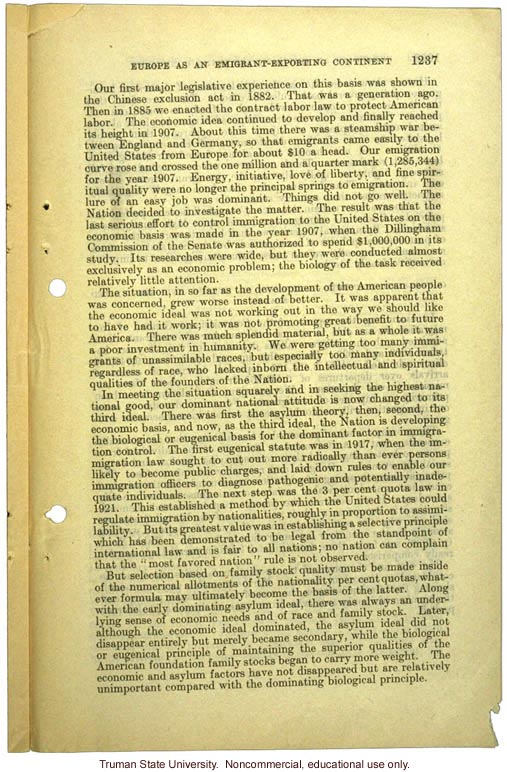"Europe as an emigrant-exporting continent," Harry H. Laughlin testimony before the House Committee, including Immigration Restriction Act (2)

"Europe as an emigrant-exporting continent," Harry H. Laughlin testimony before the House Committee, including Immigration Restriction Act (2)
1142. Europe as an Emigrant-Exporting Continent 1237 Our first major legislative experience on this basis was shown in the Chinese exclusion act in 1882. That was a generation ago. Then in 1885 we enacted the contract labor law to protect American labor. The economic idea continued to develop and finally reached its height in 1907. About this time there was a steamship war between England and Germany, so that emigrants came easily to the United States for about $10 a head. Our emigration curve rose and crossed the one million and a quarter mark (1,285,344) for the year 1907. Energy, initiative, love of liberty, and fine spiritual quality were no longer the principal springs to emigration. The lure of an easy job was dominant. Things did not go well. The Nation decided to investigate the matter. The result was that the last serious effort to control immigration to the United States on the economic basis was made in the year 1907, when the Dillingham Commission of the Senate was authorized to spend $1,000,000 in its study. Its researches were wide, but they were conducted almost exclusively as an economic problem; the biology of the task received relatively little attention. The situation, in so far as the development of the American people was concerned, grew worse instead of better. It was apparent that the economic ideal was not working out in the way we should like to have had it work; it was not promoting great benefit to future America. There was much splendid material, but as a whole it was a poor investment in humanity. We were getting too many immigrants of unassimilable races, but especially too many individuals regardless of race, who lacked inborn the intellectual and spiritual qualities of the founders of the Nation. In meeting the situation squarely and in seeking the highest national good, our dominant national attitude is now changed to its third ideal. There was first the asylum theory, then, second, the economic basis, and now, as the third ideal, the Nation is developing the biological or eugenical basis for the dominant factor in immigration control. The first eugenical statute was in 1917, when the immigration law sought to cut out more radically than ever persons likely to become public charges, and laid down rules to enable our immigration officers to diagnose pathogenic and potentially inadequate individuals. The next step was the 3 per cent quota law in 1921. This established a method by which the United States could regulate immigration by nationalities, roughly in proportion to assimilability. But its greatest value was in establishing a selective principle which has been demonstrated to be legal from the standpoint of international law and is fair to all nations; no nation can complain that the "most favored nation" rule is not observed. But selection based on family stock quality must be made inside of the numerical allotments of the nationality per cent quotas, whatever formula may ultimately become the basis of the latter. Along with the early dominating asylum ideal, there was always an underlying sense of economic needs and of race and family stock. Later, although the economic dominated, the asylum ideal did not disappear entirely but merely became secondary, while the biological or eugenical principle of maintaining the superior qualities of the American foundation family stocks began to carry more weight. The economic and asylum factors have not diappeared but are relatively unimportant compared with the dominating biological principle.
- ID: 11121
- Source: DNALC.EA


